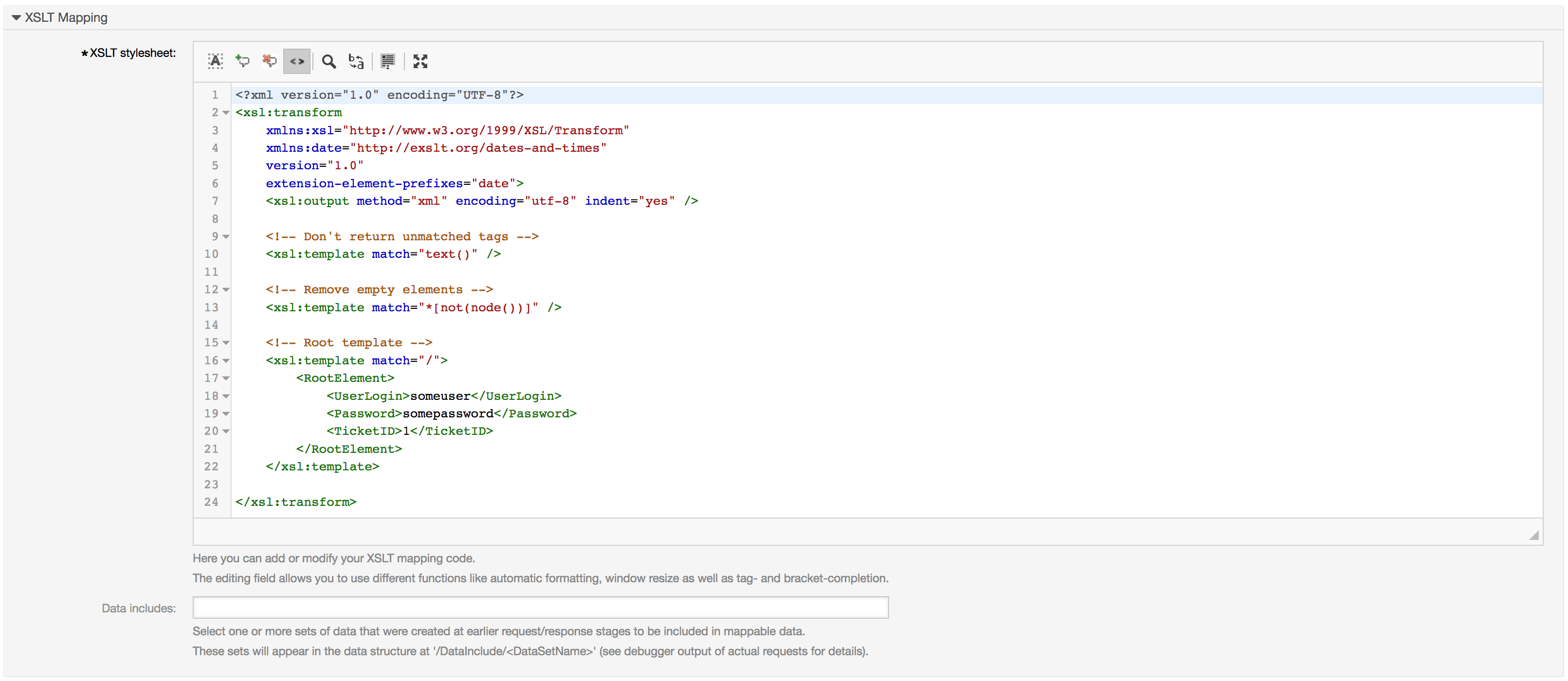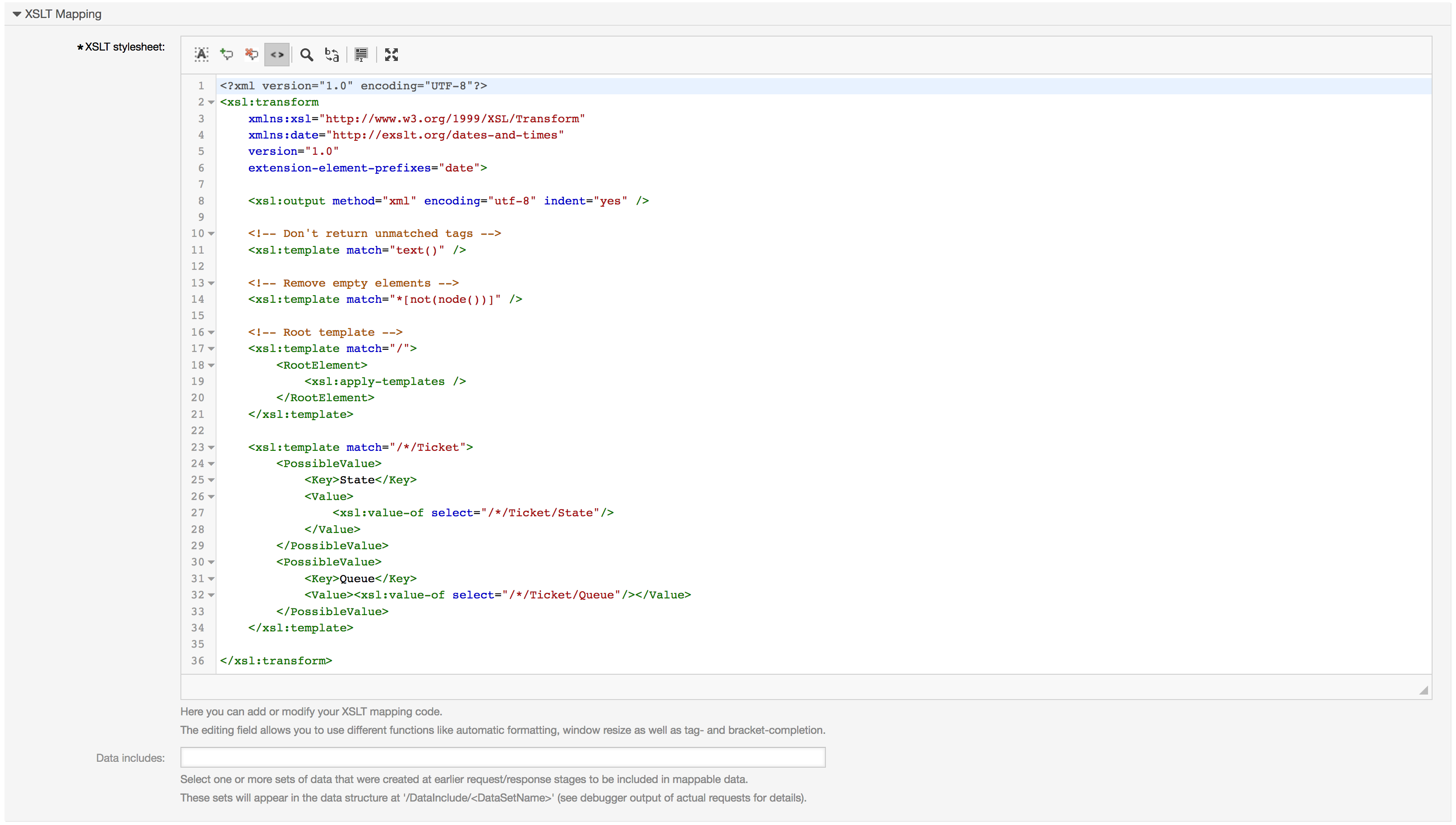This feature implements a dynamic field of the type Web Service.
This feature implements a generic dynamic field type that gathers its selectable options from an external system using a web service. The response from the external system defines the possible options to be displayed, and they could vary depending on the data that is sent in the request.
Normally when a field is changed in a screen (e.g. the ticket priority in the New phone ticket screen) the values of other fields could be updated. That is the case with this type of dynamic fields, as they could also include all screen field values in the request and the remote server could potentially return completely different values depending on input.
Additionally if the dynamic field source object already exists (e.g. a ticket, and the field is set in the Free Fields screen), the details of the already created ticket are also included in the request.
To make this feature work it is necessary to have the following components:
To create a new web service dynamic field it is necessary to have already a working web service, it
requires to have at least one invoker of the type Generic::PassThrough. This invoker
will be called to fetch the data from the remote server.
The original data that it is sent in a request is similar to the following example.
{
DynamicFieldID => 123,
DynamicFieldLabel => 'NameX',
DynamicFieldName => 'NameX',
DynamicFieldValue => 'Value',
Form => {
# Form fields
# ...
},
Ticket => {
# Ticket attributes
# ...
},
DynamicField => {
NameX => 'Value'
MameY => [ ‘Value’ ],
},
UserID => 123,
},
The Form section contains the fields in the current form in the web browser. This
information changes as the screen is filled in.
Ticket section (or another source object, e.g. CustomerUser), contains the attributes
of the object where the dynamic field belongs. For example in New phone ticket screen the section is
empty as the ticket is not created yet, but in Free Fields screen it contains the information of the
current ticket.
DynamicField section contains all non empty values of all configured dynamic fields
for the current object.
In most cases the data that the remote server requires will be very different from the data provided, so it is highly recommended to use a mapping module for the outgoing data, to format it specifically for the remote server call.
The following example shows an XSLT mapping that discards any data and sets a fixed UserLogin,
Password and TicketID (as needed for a TicketGet operation).
The response from the server can also be very different, so in this case is also very recommended to use a mapping module for the incoming data in order to be able to process the information. The response must be a list of Key and Value elements.
The following example shows an XSLT mapping that converts the results from a TicketGet operation response form the remote server, extracting and formatting the state and queue as needed to be used as options for the dynamic field.
The following web service definition (importable YAML file) can be used for testing the field, but the endpoint must be adapted to match current system. This web service acts as requester and provider and it always returns the State and Queue from TicketID 1, as possible values to the field.
---
Debugger:
DebugThreshold: debug
TestMode: '0'
Description: Dynamic Field Web Service Test
FrameworkVersion: 6.0.x git
Provider:
ErrorHandling: {}
ErrorHandlingPriority: []
Operation:
TicketGet:
Description: ''
IncludeTicketData: ''
MappingInbound: {}
MappingOutbound: {}
Type: Ticket::TicketGet
Transport:
Config:
AdditionalHeaders: ~
MaxLength: '100000000'
NameSpace: http://www.otrs.org/TicketConnector/
RequestNameFreeText: ''
RequestNameScheme: Plain
ResponseNameFreeText: ''
ResponseNameScheme: Response
Type: HTTP::SOAP
RemoteSystem: ''
Requester:
ErrorHandling: {}
ErrorHandlingPriority: []
Invoker:
TicketGet:
Description: Get possible values from the other side.
Events: []
MappingInbound:
Config:
Template: "<?xml version=\"1.0\" encoding=\"UTF-8\"?>\r\n<!--\r\nCopyright
(C) 2001-2018 OTRS AG, https://otrs.com/\r\nThis software comes with ABSOLUTELY
NO WARRANTY. For details, see\r\nthe enclosed file COPYING for license
information (GPL). If you\r\ndid not receive this file, see https://www.gnu.org/licenses/gpl-3.0.txt.\r\n-->\r\n\r\n<!--
DOCUMENTATION\r\n\r\n* Example XML Input *\r\n<RootElement>\r\n ...\r\n</RootElement>\r\n\r\n\r\n*
Example XML Output *\r\n<RootElement>\r\n <PossibleValues>\r\n <Key>???</Key>\r\n
\ <Value>???</Value>\r\n </PossibleValues>\r\n <PossibleValues>\r\n
\ <Key>???</Key>\r\n <Value>???</Value>\r\n </PossibleValues>\r\n
\ ...\r\n</RootElement>\r\n\r\n-->\r\n\r\n\r\n<xsl:transform\r\n xmlns:xsl=\"http://www.w3.org/1999/XSL/Transform\"\r\n
\ xmlns:date=\"http://exslt.org/dates-and-times\"\r\n version=\"1.0\"\r\n
\ extension-element-prefixes=\"date\">\r\n \r\n <xsl:output method=\"xml\"
encoding=\"utf-8\" indent=\"yes\" />\r\n \r\n <!-- Don't return
unmatched tags -->\r\n <xsl:template match=\"text()\" />\r\n \r\n
\ <!-- Remove empty elements -->\r\n <xsl:template match=\"*[not(node())]\"
/>\r\n \r\n <!-- Root template -->\r\n <xsl:template match=\"/\">\r\n
\ <RootElement>\r\n <xsl:apply-templates />\r\n </RootElement>\r\n
\ </xsl:template>\r\n\r\n <xsl:template match=\"/*/Ticket\">\r\n
\ <PossibleValue>\r\n <Key>State</Key>\r\n <Value><xsl:value-of
select=\"/*/Ticket/State\"/></Value>\r\n </PossibleValue>\r\n <PossibleValue>\r\n
\ <Key>Queue</Key>\r\n <Value><xsl:value-of select=\"/*/Ticket/Queue\"/></Value>\r\n
\ </PossibleValue>\r\n </xsl:template>\r\n \r\n</xsl:transform>"
Type: XSLT
MappingOutbound:
Config:
Template: "<?xml version=\"1.0\" encoding=\"UTF-8\"?>\r\n<!--\r\nCopyright
(C) 2001-2018 OTRS AG, https://otrs.com/\r\n\r\nThis software comes with
ABSOLUTELY NO WARRANTY. For details, see\r\nthe enclosed file COPYING
for license information (GPL). If you\r\ndid not receive this file, see
https://www.gnu.org/licenses/gpl-3.0.txt.\r\n-->\r\n\r\n<!-- DOCUMENTATION\r\n\r\n*
Example XML Input *\r\n<RootElement>\r\n ...\r\n</RootElement>\r\n\r\n\r\n*
Example XML Output *\r\n<RootElement>\r\n <PossibleValues>\r\n <Key>???</Key>\r\n
\ <Value>???</Value>\r\n </PossibleValues>\r\n <PossibleValues>\r\n
\ <Key>???</Key>\r\n <Value>???</Value>\r\n </PossibleValues>\r\n
\ ...\r\n</RootElement>\r\n\r\n-->\r\n\r\n<xsl:transform\r\n xmlns:xsl=\"http://www.w3.org/1999/XSL/Transform\"\r\n
\ xmlns:date=\"http://exslt.org/dates-and-times\"\r\n version=\"1.0\"\r\n
\ extension-element-prefixes=\"date\">\r\n <xsl:output method=\"xml\"
encoding=\"utf-8\" indent=\"yes\" />\r\n\r\n <!-- Don't return unmatched
tags -->\r\n <xsl:template match=\"text()\" />\r\n\r\n <!-- Remove
empty elements -->\r\n <xsl:template match=\"*[not(node())]\" />\r\n\r\n
\ <!-- Root template -->\r\n <xsl:template match=\"/\">\r\n <RootElement>\r\n
\ <UserLogin>someuser</UserLogin>\r\n <Password>somepassword</Password>\r\n
\ <TicketID>1</TicketID>\r\n </RootElement>\r\n </xsl:template>\r\n\r\n</xsl:transform>"
Type: XSLT
Type: Generic::PassThrough
Transport:
Config:
Encoding: ''
Endpoint: http://localhost/otrs/nph-genericinterface.pl/Webservice/GenericConfigItemConnectorSOAP
NameSpace: http://www.otrs.org/TicketConnector/
RequestNameFreeText: ''
RequestNameScheme: Plain
ResponseNameFreeText: ''
ResponseNameScheme: Response
SOAPAction: Yes
SOAPActionSeparator: '#'
SSL:
SSLProxy: ''
SSLProxyPassword: ''
SSLProxyUser: ''
Type: HTTP::SOAP
UseMappedData: '1'
After the proper configuration of web services, it is possible to configure dynamic fields, that use such web services.
Below is a description of the dynamic field options.
- Web service
The configured web service whose invokers will be to triggered when a dynamic field is displayed.
- Invoker
The invoker that is used to send requests to external systems. Within this field, just invokers of type
Generic::PassThroughwill be displayed.- Multiselect
A drop-down menu to determine if the displayed dynamic field should act as a multi-select field, instead of a drop-down field.
- Cache TTL
A cache time to live value, that contains a value (in minutes). If the value is 0 or empty, no caching will be active.
This cache is to prevent unnecessary requests to the remote server using the same values.
- Add empty value
Defines if it is possible to save an empty value in the field.
- Tree view
This option activates the tree view of possible values, if they are supplied in the correct format.
- Translatable values
Defines if the displayed possible values will be translated to the current user language.
Dynamic fields of type Web Service have to be activated for the several masks in which they should be displayed like the other types of dynamic fields. The following covers the cases for ticket based dynamic fields.
This can be done through Admin → Administration Overview → System Configuration, then navigate to Frontend → Agent → View.
For every Ticket* option, in which the dynamic field of type Web Service should be displayed, the
admin has to configure it to fit his needs. Examples:
TicketZoomfor the ticket zoom view.TicketPhoneNewfor new phone tickets.TicketEmailNewfor new email tickets.The dynamic field can be added if there exists an entry called
Ticket::Frontend::AgentTicket*###DynamicField. This configuration defines which dynamic fields should be displayed in this view. To add a dynamic field, the internal name of the field has to be filled in the first field. After confirmation a second field is filled with the display option. Choose 1 - Enabled to just show the field or 2 - Enabled and required to make it mandatory.

